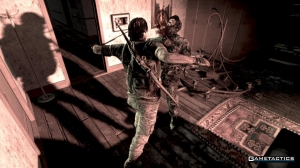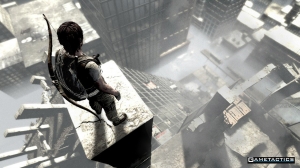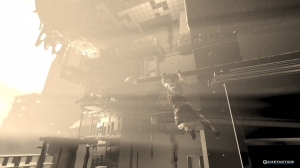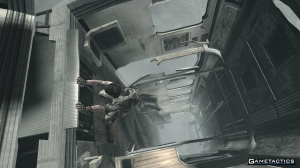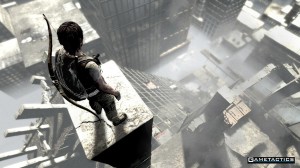 Ubisoft recently released the action intensive survival game I Am Alive. The game features a bleak outlook for a large city following a catastrophic “event” about which the player initially knows very little. I Am Alive, while available for the reasonable price of $15 on Xbox Live Arcade, is a classic case of a decent idea with middling execution. Here’s why.
Ubisoft recently released the action intensive survival game I Am Alive. The game features a bleak outlook for a large city following a catastrophic “event” about which the player initially knows very little. I Am Alive, while available for the reasonable price of $15 on Xbox Live Arcade, is a classic case of a decent idea with middling execution. Here’s why.
The player is introduced to the protagonist immediately and without much ceremony. We learn his name is Adam, and he is returning to Haventon a year after “the event” that left the city in ruins. His character is poorly fleshed out, probably in attempts to allow the player to insert themselves into the scenario. There is very little explanation for what is occurring, just a film school attempt at creative story telling using video that has been recorded at varying time frames within the continuous storyline. There can be some good said for a game that gets to the point without subjecting gamers to lengthy FMVs before they can start actual gameplay. However, in a game structured where story is such an important driving factor to complete the game, I feel this is a huge misstep.
Right off the bat, the player will notice two major things: this world is very gray, and this protagonist is not very bright. When I say the world is very gray, that’s an understatement. Do not attempt to adjust the color levels of your tv, this game is pretty much in grayscale. It’s almost like a parody of the Unreal Engine color scheme. The explanation for this is that the city is covered in ash, and of course, to build atmosphere. While there are details to explain how gray everything is, there is sparse description about the city of Haventon itself. We know Adam has returned because he is looking for his family, but there is no initial explanation given for the year it took him to return. He has also decided that trekking through a ruined city only requires one water bottle and one can of food, and somehow thinks there’s a good chance his family will be waiting for him in their old apartment. Low supply stock is a theme found throughout the game. It’s not a terrible way to add challenge to gameplay, but it seems unfounded for when the player first arrives.
Adam spends most of his time climbing ruins and much less time confronting survivors. This is somewhat of a saving grace, as combat is implemented in a non-adaptive manner. Various options are presented to the player when approaching a survivor, most of them constrained by how hostile the survivors are and what kind of supplies are available to the player. Bullets are extremely scarce, which means the player will often need to intimidate with an empty gun and take down enemies one by one with a machete. Groupings of enemies offer little foreshadowing of what to expect in future groups, changing quickly from smaller to larger groups with no real consistency or way to let the player know when to conserve or spend their limited ammo. It feels like improvisation is encouraged in battle scenarios, but the difficulty level is too disjointed and doesn’t progressively get harder or easier.
Most of the game progress involves creative rehashings of buildings which must be scaled or descended. Adam can usually be found spending so much time climbing because he is basically the only person in Haventon who can help all the needy survivors. This could be viewed as another weak point in the story, since the main arc is so bone thin and predictable, things that should be side missions become the main mode of progress to complete the game. The player can find useful tools later in the game, such as the grappling hook that is usable in certain locations. This makes the climbing a little less monotonous and allows it to play out more like a puzzle than a platformer. The major challenge to climbing is thinking on the go, trying to figure out paths and get to the next area, all while your stamina is dropping rapidly. This is made obvious in the game by the crescendo of urgent instruments inciting panic as you strain to grasp for that final ledge. Stamina is almost too stingy in the game, which wouldn’t be such a large issue if not for the fact that the controls are not as smooth and precise as they should be, sometimes leaving the player going in a direction they didn’t even press. When every excess microsecond could lead to a fall, this is pretty important.
Combat and climbing flaws could be forgivable if not for the saving structure in this game. Episodic gameplay meets autosaves is not a new concept, but for some reason, it seems to add less challenge to this game and more frustration. Autosaves are far too infrequent and not triggered by the points in the story where they feel they should be. I know the immediate reaction will be that lack of saves and having to use a limited number of retries before having to restart an entire mission level is supposed to be challenging. This game has them so sparsely, though, it’s like the game is punishing you for having a life outside of it. You won’t find yourself replaying sections of the game four times because you had trouble beating them, but rather because you had to turn off your console before the game felt it was okay for you to do so. And for a game that lacks compelling characterization, originality, and a compelling storyline, that’s unfair.
To top off your experience of this game, be sure to watch out for major glitches. Major glitches such as the game only loading 95% of your most recent save. This means you have to restart that entire section of the story because your save file corrupted itself, as if the already existing limitations of saving in the game weren’t making you replay sections enough! I Am Alive should have been much more than what it is after four years in development and an entire redesign. The $15 dollar price tag is almost an apology for the game not meeting its potential. The underlying promise of the game is enthralling, but unfortunately, the effort put into developing that concept was underwhelming. I Am Alive harkens the shadow of the better game it should have been, which is worse than being an outright terrible game.
Gameplay
Graphics
Sound
Overall
Screenshots:

